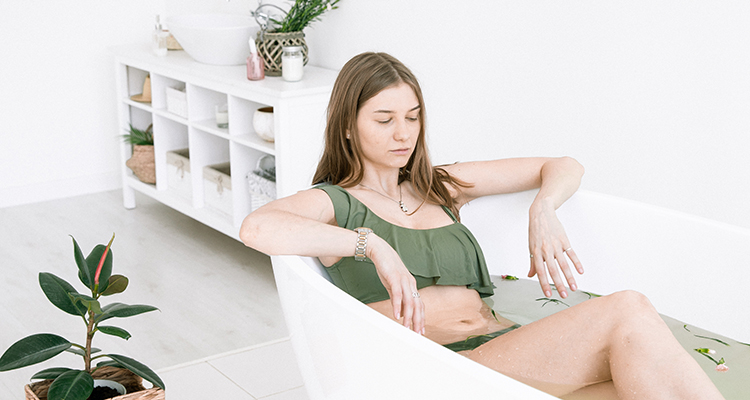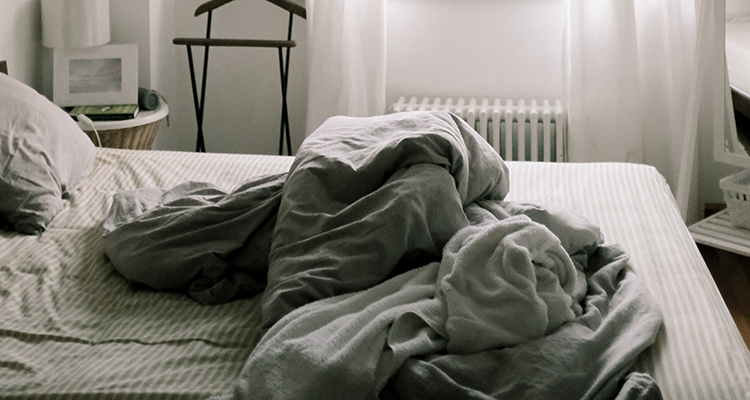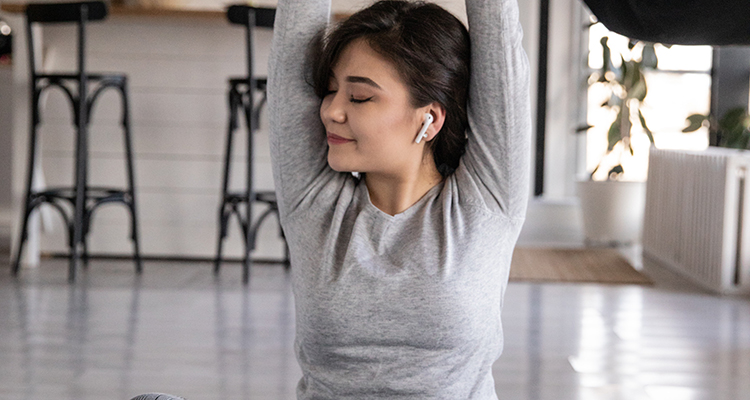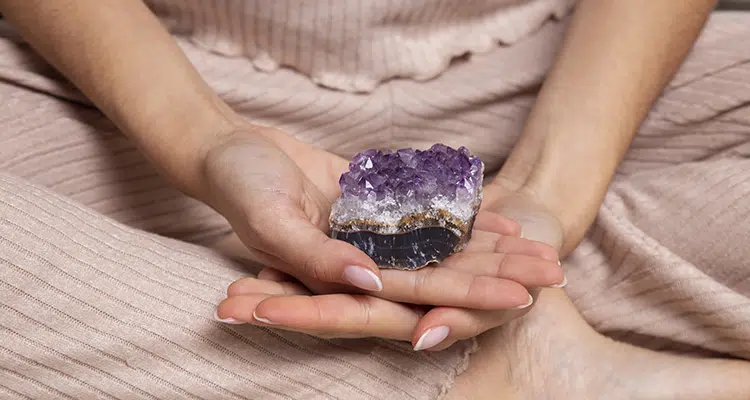What To Do When You Can’t Sleep
Sleep is vital for all of us. Having the right amount of restful sleep enables our body and mind to function properly throughout the day. Without it, we can struggle to complete daily tasks and find that we’re irritable, anxious and even depressed.

Content
Prevention is best
Preventing issues with sleep is better than trying to deal with sleep problems! We can increase our chances of a restful sleep by practicing good sleep hygiene. The National Sleep Foundation explains that sleep hygiene is, “a variety of different practices and habits that are necessary to have good nighttime sleep quality and full daytime alertness.”

Let’s take a look at positive sleep hygiene practices you can introduce to your routine to help you get the sleep you need.
Make your bedroom a sleep sanctuary
Your bedroom should be a comfortable, calming space which is conducive to sleep. It’s important that your bedroom is the right temperature, ideally between 60 and 67 degrees Fahrenheit. When it’s too hot or cold, it can make you restless and wake you up. You could use humidifiers, fans or heaters to help make your bedroom the right temperature.
Lighting plays a vital part in preparing your bedroom (and yourself) for sleep. Our circadian rhythm is like our internal body clock: it reacts to light, among other environmental factors, to determine when we should sleep. Ideally the lights you use in your bedroom at night should be dimmed to help you adjust for sleep. When you’re ready to sleep, your bedroom should be as dark as possible. You could use blackout curtains, blackout blinds or even an eye mask.
Making your bedroom as cosy and comfortable as possible is incredibly important. Ensure you have a comfortable bed, mattress and pillows. If you don’t, it’s well worth investing in them to improve your comfort level and give you the support you need (if resources allow). If you aren’t in a position to invest in a new bed or mattress, you could try a mattress topper to increase your comfort level. You could choose to add blankets, cushions and other personal touches to make your bedroom feel like a cosy sanctuary.
It’s important that your mind makes the association between the bedroom and sleep. You can do this by ensuring you don’t do any stimulating activities within the bedroom, such as working or watching TV. Your bedroom should only be for sleep, relaxation and sex. This helps your brain to make the connection that when you go into the bedroom, you’re going to be in that relaxed state of mind.
Wind down before bed
Giving yourself some time to relax and unwind before you head to bed is important. If you’ve been busy, or even just watching TV, your mind is in that awake, alert state. You need to help it transition into a relaxed state ready for sleep. This article explains that, “A regular nightly routine helps the body recognize that it is bedtime.”

Control what you eat and drink before bed
What you consume before you go to bed plays a significant role in how well you sleep. If you consume stimulants such as alcohol, caffeine, or nicotine too close to bedtime, this can keep you awake. You should also try to reduce the amount you’re drinking as you get closer to bedtime, to prevent you having to get up in the night to go to the toilet.
You should avoid eating a big meal close to your bedtime, as this can cause you to feel bloated and uncomfortable when you’re trying to sleep. Likewise, if you go to bed hungry this can keep you awake: a light snack before bed can be a useful way to mitigate this problem. Avoid heavy, rich or fatty foods before bed as they are harder to digest and can cause stomach upset or heartburn.
Have a consistent sleep schedule
Consistency really is key when it comes to a sleep schedule. You should try to go to bed at roughly the same time each night, and wake up at around the same time each morning. This helps you to reset your body clock and will make you more likely to sleep restfully.
Turn off electronics before bed
Since electronics create a light source, they can interrupt our circadian rhythm and make it harder to get to sleep if we use them close to our bedtime. This article explains that blue light (emitted from electronic devices), “delays your body’s internal clock (a.k.a., your circadian rhythm), suppresses the release of the sleep-inducing hormone melatonin”.

If you must regularly interact with screens there are some great options out there to help. Blue light blocking glasses or screen filters are a great way to avoid blue light exposure if you’re looking at screens late at night.
Get out in natural light during the day
Just as limiting light at night can help to regulate your circadian rhythm, so can getting out in natural light during the day. By experiencing more natural light, it helps us to feel more awake during daytime. This article from the Division of Sleep Medicine at Harvard Medical School explains that, “Natural light keeps your internal clock on a healthy sleep-wake cycle.”
Exercise during the day
Exercising during the day helps to reduce stress, regulate your mood and tires your body and mind out in a healthy way, which promotes better sleep. It’s important not to do vigorous exercise in the few hours before you go to bed, as this can make you feel more awake.
Reduce or eliminate naps
Short naps of around 20-30 minutes during the day can help you to feel more energized. However if you’re struggling to sleep at night, naps can make you less tired when it’s bedtime. Try to reduce the amount of naps you’re taking, or even cut them out all together: this may improve your ability to sleep at night.
Take the pressure off
If you find that you can’t fall asleep, or you wake up during the night and can’t get back to sleep, one of the first things you can do to reduce worry is take the pressure off being unable to sleep. There are a few ways you can do this.

Don’t panic
It’s natural to start worrying about the fact that you can’t sleep and thinking about how tired you will be the next day. Instead, try not to panic. Remind yourself that getting stressed isn’t going to help you solve the problem. Take a few deep breaths and stop your mind spiralling.
Focus on relaxation rather than sleep
Instead of focusing on how you can get back to sleep, focus on relaxing your mind and body. You could listen to some relaxing music or a guided meditation to help you unwind. You could picture all of the tension leaving your body and feel your body sinking into the bed.
Understand your body is still getting rest
One of the things that has helped me most when dealing with being unable to sleep, is realising that even if I’m not asleep, if I’m lying in bed and relaxing my body and mind are still getting rest. That time is still valuable and useful. This takes away a lot of the anxiety around sleeping and usually ends up in me falling asleep.
Don’t look at the clock
It’s common to keep looking at the clock if you’re not sleeping. You might find yourself thinking, “If I fall asleep now, I’d get 6 hours of sleep”, or “even if I get to sleep now, I’m only going to get 3 hours!” We’ve all been there! However, this only fuels the cycle of being unable to sleep. It’s a good idea to stop yourself looking at the clock: turn clocks away from you so you can’t see them from your bed, or even remove them from the bedroom.
Get up and change your environment
If you can’t sleep within 20 to 30 minutes of going to bed, it’s time to move to another room. As we’ve mentioned, it’s so important for your mind to associate being in bed with sleep, and lying awake can have the opposite effect. You can think of this like training your mind and body to feel ready for sleep when you’re in your bedroom. This article from the American Academy of Sleep Medicine states that, “physicians recommend that you get out of bed and spend some time doing a quiet, relaxing activity until you are tired.”

The key is doing a relaxing activity, not something which is going to wake you up more. You should move to a quiet, dark room with dimmed lights. You shouldn’t watch TV or play around on your phone. Try not to dwell on stressful thoughts or plans for the next day. Instead you should focus on reading a book, listening to an audio book, or listening to relaxing music for example. When you start to feel more tired, you can return to bed and try again to sleep.
Practice relaxation techniques
Relaxation techniques can be incredibly useful in helping you to get to sleep and reducing stress around not being able to sleep.

Meditation
Listening to a guided meditation can be very effective in getting you into a calm mindset and relaxing tensed muscles. There are lots of great places online where you can access guided meditations specifically designed to help you sleep, such as through an online insomnia treatment. You could choose to do a mediation on your own if you are used to practicing mindfulness.
Meditations could be carried out in bed to help you drift off to sleep, or you could move to another room, as we mentioned previously, and meditate before returning to bed.
Progressive muscle relaxation (PMR)
PMR is a form of mindfulness which guides you through tensing each muscle group then relaxing them, to promote a sense of complete body and mind relaxation. You can learn to carry out PMR on your own. This article from Johns Hopkins Medicine explains that you should, “work your way through the different muscle groups in your body (e.g. arms, legs, torso, face) tensing the muscles in each group at about three-quarters strength for approximately five seconds before releasing the tension all at once.”
Alternatively you can listen to a guided PMR session which you find online or through a specialized sleep therapy programme. The audio will guide you through each stage of PMR with clear, calm instructions. Often these audios can be very relaxing in themselves as the voice is slow and steady, encouraging you to unwind.
Use visualization
Visualization can be a powerful relaxation tool. When using visualization for sleep, you can focus on picturing happy memories. You can do this yourself by actively thinking about a time you felt relaxed and happy. It could be when you were on holiday, lying on the beach for example. Try to really see the memory in your mind. Imagine you’re there. What can you see, hear, touch, taste and smell? Engaging the senses helps us to imagine being there more vividly. If you find your mind wandering, simply bring your focus back to the image in your mind.

You could choose to imagine yourself in your ideal calm situation. For example, you could picture yourself getting a massage, or walking through a beautiful, quiet garden. As with the memory, engage your senses and focus on how relaxed you feel in that imagined place. Not only does visualization help us to be in a more relaxed state, it also prevents our mind from wandering or worrying.
Guided visualization involves listening to an audio recording, similar to the meditation and PMR we discussed. A steady, comforting voice will guide you through setting a very calm scene in your mind, and often relaxing sounds will be played in the background to help you visualize the scene. Don’t worry if you struggle to maintain focus at first, this can take time to get the hang off. The more you practice, the better you’ll get at focusing your mind on the scene you’re visualizing, letting all the stress fall away.
Breathing exercises
Breathing exercises can be a simple, very useful tool aiding in relaxation. There are different breathing exercises you can try. A simple breathing exercise involves you focusing on each breath in and out you take, noticing how it feels and sounds. If your mind wanders, bring your attention back to your breathing. This exercise takes your attention away from your worries and keeps you in the present.
Diaphragmatic breathing, or deep breathing, involves taking a deep breath in and holding that breath for three or four seconds and then releasing it. Try to make each breath as deep as you feel comfortable with. As you breathe in, you can feel your stomach rising (rest your hand gently on your stomach if this helps you). Tighten your stomach muscles and feel your stomach fall as you breathe out. As you release each breath, imagine all of the stress leaving your body. As you inhale, imagine you’re bringing a sense of relaxation into your body.
These are just a couple of breathing exercises you can try: there are lots of others to explore. As with other relaxation techniques we’ve mentioned, guided breathing exercises can help to take you through to process step by step.
Listen to an audio book
Listening to an audiobook can be a great way to relax while distracting your focus from any worries. Often the voices reading the audio books are very steady and calming, aiding in the relaxation process. Listening to audiobooks through earphones can even help to drown out external noises which may be disturbing you.

Listen to calming sleep sounds
Often what disturbs our sleep, especially when we’re first trying to drift off, is noise! Whether it’s a partner snoring, a car door slamming outside or the sound of a TV playing from another room, external sounds can alert our senses and startle us out of our relaxed state. One way to deal with this and promote relaxation, is listening to calming sleep sounds.

Sleep sounds mask other noises to help create a steady flow of calming noise which helps you drift off. Low frequency, repetitive sounds work best for relaxation. The type of sleep sounds typically used vary. They can include water sounds which could include the sound of a babbling river, rain falling, or waves breaking. This article from the Alaska Sleep Education Center explains that, “By creating a mental state of relaxation, contentment, and gentle focus, the wave sound can be deeply relaxing.”
Nature sounds can also be very calming, such as the sounds of the forest, wilderness or wildlife. Scientists at the University of Sussex studying the use of nature sounds for sleep and found that, “participants’ nervous systems moved toward a more relaxed, “rest and digest” mode of activity after listening to recordings from nature.” You can access sleep sounds through personalised sleep therapy, through other online resources, or using a sleep sound machine.
Listen to calming music
Another great way to relax is by listening to calming music with slow rhythms. Calming music is proven to lower blood pressure, slow heart rate, and reduce anxiety. The National Sleep Foundation explains, “Relaxing tunes – like classical music – may help you wind down and fall asleep faster (but skip songs that have words, because those may actually stimulate you).”

Don’t worry if you fall asleep with your music still playing: falling asleep while listening to music can even help to boost your memory formation and improve brain function!
White noise
This 2020 article explains that white noise is, “when sound waves of a broad spectrum of frequencies are combined, forming a sound similar to the constant hum a fan creates when it’s blowing air.” A white noise machine will create its own white noise and play it repeatedly, helping to drown out other sounds in the environment. This constant steady sound helps you to be less startled by other noises and promotes a deeper, more restful sleep.
Challenge negative thoughts
As we’ve mentioned, when we can’t sleep we often become very anxious and worried about not being able to sleep. It’s common to have very negative thoughts when you’re lying in bed awake such as, “I’m never going to get to sleep” or “If I don’t get to sleep, I’m never going to do well at work tomorrow”. While these thoughts are understandable, they’re maladaptive (meaning unhelpful). They actually fuel a cycle of stress and insomnia, and make it even harder to sleep. The NHS states that research has shown, “shorter sleep and delayed ability to get to sleep are associated with repeated negative thoughts”.

By challenging these negative thoughts and replacing them with more realistic, positive thoughts, we can help ourselves break this cycle. When you find a negative thought creeping into your head, stop yourself and take a deep breath: instead replace this thought with a more adaptive (helpful) thought.
For example, if you think “everyone else can sleep and I can’t”, instead remind yourself that realistically, “everyone has problems sleeping now and then”. If when you’re going to bed you find yourself thinking, “there’s no way I’m going to get to sleep tonight”, instead replace your thought with something like, “I can’t know what’s going to happen, maybe I can use relaxation techniques and sleep really well.”
Although this can feel a little bit cheesy at first, it really does help! How we perceive our ability to sleep and the feelings we have around sleep have a marked impact on our ability to get to sleep. The more you practice challenging negative thoughts, the more natural it will feel.
Thought blocking
Just as we can challenge negative thoughts, we can also block them. Let’s take a look at how we can do this!

Repeat a word
One of the best ways to block a thought is through a process known as articulatory suppression. This method has been around for a long time and is still very effective. This simply means that you repeatedly mouth a word at a quick speed. This article explains that, “the theory is that mouthing a word requires a lot more mental power than just thinking it and the use of that mental power causes a blocking of the original intrusive thought.”
The word can be anything as long as it doesn’t hold emotional significance to you, or evoke any particular reaction. It could be something simple like the word ‘and’ or ‘the’. You can do this as many times as you need to move your mind away from stressful thoughts.
If you find that your stressful thoughts are attached to imagery, (meaning you’re picturing something in your mind when you’re having these thoughts), it can be useful to add an image to this distraction process. The image should be simple, and like with the word, not evoke an emotional reaction. A shape is often used, such as a triangle, which you picture in your mind as you mouth your chosen word. This helps to distract your mind further.
Do a mental puzzle
Adding onto the previous exercise, you could choose to add a mental puzzle to the world you’re mouthing. For example, you could count upwards (for as long as you need) in multiples of three: 3, 6, 9, 12 and so on until you reach 1000 or more. It’s all about keeping your mind so busy that it can’t dwell on other thoughts.
Focus on the good
Another way to block negative thoughts, is to focus on unrelated positive thoughts, such as things which make you happy in your life. Some research has shown improvements in sleep when participants consistently focused on things they were grateful for when lying in bed. If you find your mind wandering, try actively thinking about the good in your life.
Comfort yourself
No matter how old we are, if we can’t sleep and are over-tired, we need some comfort. There’s absolutely nothing wrong with comforting yourself. This might even help you to feel more relaxed so you can get to sleep.

Hot water bottle or wheat pack
Heat can soothe sore muscles, ease tension and help us to feel comforted. Filling a hot water bottle or using a wheat pack which you heat in the microwave can be very soothing. Some wheat packs have comforting smells such as lavender which can add an extra level of relaxation.
Essential oils
While research on essential oils is mixed, they’ve been used for years to aid sleep and relaxation, among many other uses. There are no side effects, so it can’t hurt to try them. Often lavender is the most used scent for relaxation and stress relief. There are plenty of others which can be beneficial for sleep including vanilla, rose, geranium, jasmine, and sandalwood. You can play around to see what works for you.
Essential oils can be bought in rollers which you apply to your pressure points. They can be added to your bath before bed to help you unwind. You can also use them in an oil diffuser. You can even buy pillow sprays with a mix of essential oils which you spray onto your pillow before bed so you can smell the scent as you drift off.
A warm drink
Sometimes a warm drink can be so soothing. You could incorporate this into your wind down routine before bed, or even make one if you can’t sleep in the middle of the night. Warm milk or decaffeinated tea would be best, as you don’t need anything with caffeine in it making it harder for you to sleep.
An extra blanket or pillow
Sometimes a simple act like getting yourself an extra blanket to snuggle up under, or an extra pillow for added comfort, can be enough to soothe yourself to sleep. Comfort is key, so it’s worth experimenting to see what feels most comfortable for you.
Tackle the root cause
If you find that you are regularly not sleeping well, it’s time to try to pinpoint and tackle the root cause of your sleeping problems.

Keep a sleep diary
A great place to start is keeping a sleep diary. You can find templates for these online, access one through your doctor, or use a sleep therapy programme. You should note down things like:
- What time you went to bed and got up
- How long it took you to get to sleep
- How many times you woke up during the night and for how long
- Whether anything specific disturbed your sleep
- What the quality of your sleep was like
- What you ate and drank before bed
- Whether you did any exercise
- Whether anything in particular was on your mind
- How you felt emotionally as you headed to bed
- What medications you took and when
- Whether you made time to wind down before bed
A diary like this can help you to see patterns and pinpoint what may be causing your lack of sleep, so that you are able to do something about it. It can also help your doctor to get a clearer view of what’s going on if you decide to seek medical help for your sleep problems.
Write down your worries
If you find that you’re often having the same worries on your mind at night and they are interfering with your sleep, writing them down can be helpful. Not only does this allow you to get them off your mind, it can also help you to identify them. Once you know what you’re concerned about, you can figure out how to deal with it.
If you’re awake during the night and you’ve tried everything else and simply cannot get back to sleep, you could try jotting down things that are on your mind in the moment. As you write them down, imagine them leaving your body, the stress melting away. The page will contain them and you can deal with them during the day. This can help to ease your mind and allow you to focus on relaxation techniques to help you get to sleep.
Be proactive with comorbid conditions
Many people with chronic pain and mental illness (among other conditions) struggle to sleep at night. If you have comorbid physical or mental health conditions and they are contributing to your lack of sleep, it’s important to be proactive in lessening their symptoms so that you can get the rest you need.

Self management techniques could include taking medication, using management techniques you’ve learnt through therapy, or easing chronic pain with a heat pack for example.
Tackle disturbances
If there are external disturbances which are disrupting your sleep, try to deal with them head on. If there’s a noise from outside or your partner is snoring, try using headphones or earplugs to drown out the noise. If you’re too cold, try adjusting the heating and adding an extra blanket. If you’re too warm, turn on a fan. If light is coming in through the window despite your curtains, try a sleeping mask. Doing your best to make your environment as conducive to sleep as possible can really help.

Seek treatment
If you are having regular sleep problems or you feel you might have a sleep disorder, seeking help can be very beneficial.

See your doctor
If you are worried about your sleep issues, you could go to your GP and bring up your concerns. If they feel you have a sleep disorder, they might refer you to a sleep clinic. This isn’t anything to worry about, it’s simply a clinic which specializes in sleep disorders with experienced staff who will be able to properly assess you and figure out what’s going on. From there, you will have a better idea of what help you need. They might prescribe medication to help you, or refer you for psychological therapy.
Use online sleep therapy
If you struggle with insomnia, you could choose to use an online sleep therapy programme. Depending on the programme, various treatment methods will be used to help you get relief from your sleep problems in your own home, in your own time. This eliminates waiting lists and is often a lot more cost effective than other options.
Somnus is a sleep therapy programme which will tailor sleep treatment specifically designed for your needs. Using the programme you can access a variety of scientifically proven, natural treatment methods which can help you sleep and improve the quality of your slumber!
To reduce the blue light we mentioned earlier, online sleep resources can be used on dark mode to maintain good sleep hygiene. A lot of the techniques you will use close to bedtime or in bed are based on audio (such as guided meditations), so you won’t even need to look at your phone, tablet or laptop to use them.
Psychological therapy
Now we know where you can access help, let’s take a look at what help is available.There are many psychological therapies which can help to improve sleep.

Cognitive behavioural therapy for insomnia (CBT-I)
CBT-I is one of the primary treatments for insomnia and is proven to have positive results for patients. CBT-I uses multiple methods to help you change your thoughts and behaviours around sleep. Two of the most commonly used techniques are:
- Sleep restriction therapy: This technique involves reducing the amount of time you are in bed and eliminating naps during the day, with the aim of resetting your body clock.
- Stimulus control therapy: This technique helps you identify sleep habits and external stimuli which are interrupting your sleep, you can learn to control them and improve your sleep.
Mindfulness
Mindfulness is all about being in the present moment, releasing stress and promoting relaxation. This can be extremely useful for sleep, as we’ve previously mentioned. Guided mindfulness is often combined with other therapies, such as CBT-I, to bring the best results for patients.
If you aren’t sleeping well, don’t lose hope. You’re not alone, and there are lots of effective ways you can get things back under control and get the rest you need!
References
National Sleep Foundation, (2020), “Sleep Hygiene”.
National Sleep Foundation, (2020), “Why Electronics May Stimulate You Before Bed”.
Division of Sleep Medicine, (2007), “Twelve Simple Tips to Improve Your Sleep”. Harvard Medical School.
Patrick Murray, (2014), “What to do when you can’t sleep.” American Academy of Sleep Medicine.
Johns Hopkins Medicine, (2020), “Up in the Middle of the Night? How to Get Back to Sleep”.
Caitlin Reynolds, (2018), “8 Relaxing Sounds to Help You Sleep”. Alaska Sleep Education Center.
National Sleep Foundation, (2020), “Sleep and Sound”.
Sharon Basaraba, (2020), “How to Use White Noise for Sounder Sleep.” Very Well Health.
NHS, (2014), “Lack of sleep linked to negative thinking”.
Sleepstation, (2020), “Can’t sleep? Overthinking? How thought blocking can help”.
The Sleep Council, (2020), “Sleep Diary”.
National Sleep Foundation, (2020), “Treatment”.

















